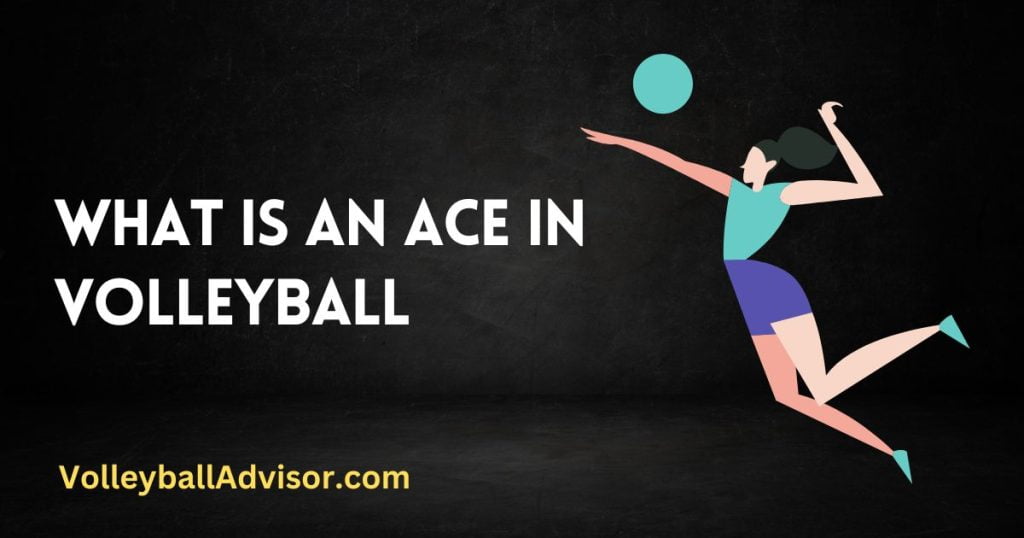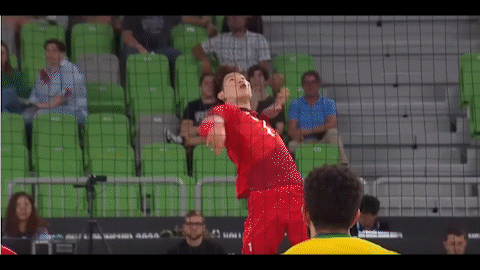An ace in volleyball is a point scored directly from a service that is not successfully returned or touched by the receiving team.
It occurs when the server delivers a service that is either too difficult for the opposing team to handle or when the serve lands in the opponent’s court without being touched.

An ace is a powerful and advantageous play in volleyball, as it allows the serving team to score a point immediately without engaging in a rally.
This scoring move demonstrates the server’s skill and can create momentum shifts in a match, often putting psychological pressure on the opposing team.
The importance of scoring and various ways to score points:
Scoring is the primary objective in volleyball, and there are several ways a team can score points.
Teams can score by successfully landing an attack in the opponent’s court, by capitalizing on the opponent’s errors, or by scoring directly from a serve.
Scoring points is essential for winning sets and, ultimately, matches. Understanding the different ways to score and mastering various techniques is crucial for a team’s success.
Introducing the concept of an “ace” in volleyball:
One of the most effective and powerful ways to score points in volleyball is by serving an “ace.”
An ace is a point scored directly from a serve without the receiving team being able to touch or return the ball.
This article will explore the concept of an ace in volleyball, its impact on the game, and the skills and techniques involved in achieving an ace.
What is an Ace in Volleyball?
An ace in volleyball is a point scored by the serving team when their serve is not returned or touched by the receiving team. This powerful scoring move is a testament to the server’s skill and can have a significant impact on the outcome of a match.

How an ace occurs during gameplay:
An ace occurs when a player serves the ball, and it either lands inbounds within the opponent’s court or touches an opposing player before going out of bounds, without the receiving team successfully making contact to return it.
Aces can result from various factors, including the server’s power, placement, or deception, as well as the receiving team’s positioning and reception skills.
Differentiating between an ace and other scoring plays:
An ace is a unique scoring play in volleyball as it does not involve a rally or exchange between the teams.
It is a direct result of the server’s actions and occurs without any further involvement from the server’s teammates.
Other scoring plays, such as kills, blocks, or points resulting from the opponent’s errors, involve an exchange or rally between teams and usually require the collaborative effort of multiple players on the scoring team.
In summary, an ace is a point scored solely from a serve, while other scoring plays involve teamwork and additional gameplay.
Types of Serves that can Lead to an Ace
In volleyball, the serve is a crucial skill that can significantly impact the outcome of a game.
A strong, well-placed serve has the potential to result in an ace, which is a point scored directly from the serve without any contact from the receiving team.
There are various types of serves that players can master to increase their chances of scoring an ace.
This section will discuss four common serves that can lead to an ace and explain their characteristics and execution.
A. Float serve:
The float serve is a strategic serve that relies on minimal spin and unpredictable movement, making it difficult for the receiving team to predict its trajectory.
The server contacts the ball with a flat palm, creating a knuckleball effect.
This serve can lead to an ace if the receiving team misjudges the ball’s path or is caught off guard by its sudden changes in direction.
B. Jump serve:
The jump serve is a powerful and aggressive serve that combines speed and height to challenge the receiving team.
The server tosses the ball high, takes a few steps, and jumps to strike the ball at its peak with a powerful, downward motion.
The speed and angle of this serve can make it difficult for the receiving team to react, often resulting in an ace.
C. Topspin serve:
The topspin serve involves the server applying topspin to the ball by snapping their wrist upon contact.
This serve causes the ball to dip quickly after crossing the net, making it challenging for the receiving team to judge the ball’s landing point.
A well-executed topspin serve can catch the opposing team off-guard and result in an ace.
D. Jump float serve:
The jump float serve combines elements of the jump serve and the float serve.
The server tosses the ball and jumps to strike it with a flat palm, similar to a float serve, but with added height and speed from the jump.
This serve can be highly effective, as it combines the unpredictability of the float serve with the power and speed of the jump serve, making it difficult for the receiving team to anticipate and return the ball, thus increasing the chance of scoring an ace.
Factors that Contribute to a Successful Ace
Scoring an ace in volleyball is a result of various factors working together to create the perfect serve.
While the server’s skill and technique are essential, other elements such as serve placement, the opposing team’s reception skills, and game strategy also come into play.
Understanding these factors can help players refine their serving abilities and increase the likelihood of scoring aces.
In this section, we will delve into the key aspects that contribute to a successful ace in volleyball.
A. Server’s skill and technique:
The server’s skill and technique play a significant role in achieving a successful ace.
A skilled server can generate power, accuracy, and deception with their serves, making it challenging for the receiving team to predict and return the ball.
Mastery of various serving techniques, such as the float serve, jump serve, topspin serve, and jump float serve, can enhance a player’s ability to score aces.
B. Serve placement and trajectory:
The placement and trajectory of the serve are crucial factors in scoring an ace.
A well-placed serve can target the receiving team’s weak spots or seams, exploiting gaps in their formation or forcing less skilled receivers to handle the ball.
The trajectory of the serve, such as a high-arching topspin serve or a fast and low float serve, can also make it difficult for the receiving team to anticipate and react to the ball’s movement.
C. Opposing team’s reception skills:
The receiving team’s ability to handle and return serves plays a significant role in whether a serve results in an ace.
A less skilled receiving team may struggle to handle powerful or deceptive serves, increasing the likelihood of an ace.
Conversely, a team with strong reception skills can effectively neutralize even the most challenging serves, making it harder for the server to score an ace.
D. Game strategy and tactics:
Strategic and tactical decisions made by the server and their team can also contribute to a successful ace.
The server may employ various tactics, such as varying the type, speed, or placement of their serves, to keep the receiving team off-balance and guessing.
Additionally, the serving team may analyze the receiving team’s formation, strengths, and weaknesses to identify potential vulnerabilities and adjust their serving strategy accordingly.
The Impact of an Ace on a Match
A. Psychological effects on both teams:
An ace can have a significant psychological impact on both the serving and receiving teams.
For the serving team, scoring an ace can boost confidence, motivation, and team morale, as it demonstrates the server’s skill and gives the team an immediate point.
On the other hand, the receiving team may experience increased pressure, frustration, and a decrease in confidence after being unable to return a serve.
These psychological effects can influence the performance of both teams throughout the match.
B. Momentum shifts and game tempo:
A well-timed ace can shift the momentum of a game in favor of the serving team.
By scoring a point without engaging in a rally, the serving team can disrupt the receiving team’s rhythm and force them to adjust their tactics.
Additionally, a series of aces can create a significant lead, changing the game’s tempo and putting the receiving team on the defensive.
These momentum shifts can play a crucial role in determining the outcome of a match.
C. Contribution to individual and team statistics:
An ace contributes to both individual and team statistics, reflecting the server’s skill and the team’s overall serving strength.
Players who consistently score aces are often seen as valuable assets to their teams, as their serving prowess can create scoring opportunities and apply pressure on the opposing team.
Team statistics that include a high number of aces can be indicative of a strong serving team, which may have a competitive advantage in matches.
Famous Volleyball Players Known for their Aces
Top players with strong serving abilities
- Karch Kiraly (USA) – Widely regarded as one of the greatest volleyball players of all time, Kiraly was known for his powerful jump serves that often led to aces, contributing to his numerous Olympic and World Championship titles.
- Sergey Tetyukhin (Russia) – A versatile player and four-time Olympic medalist, Tetyukhin’s skillful jump serves and float serves made him a formidable server and a critical component of Russia’s national team.
- Zhu Ting (China) – A dominant force in women’s volleyball, Zhu Ting’s powerful jump serves and strategic placement have helped her achieve numerous individual awards and team championships, including Olympic gold and FIVB World Cup titles.
- Ivan Zaytsev (Italy) – Known as “The Tsar,” Zaytsev is a prolific server with a powerful jump serve that has earned him a reputation as one of the best servers in the men’s game, contributing to his numerous international titles.
Notable ace records and achievements:
- Karch Kiraly holds the record for the most aces in a single match in FIVB Men’s World Championship history, with 14 aces against Korea in 1986.
- In women’s volleyball, the record for most aces in a single match in FIVB World Championship history is held by Serbia’s Tijana Boskovic, with 11 aces against the Dominican Republic in 2018.
- During the 2021 Tokyo Olympics, the USA’s Jordan Thompson scored 8 aces in a single match against the Russian Olympic Committee, setting a new record for the most aces in a single women’s Olympic match.
Conclusion
Scoring an ace in volleyball is a powerful and effective way to gain an immediate point, showcasing the server’s skill and technique.
A well-executed ace can influence the psychological state of both teams, shift the momentum of a match, and contribute to a team’s overall success.
By understanding the various types of serves that can lead to an ace and the factors that contribute to a successful ace, players can refine their serving abilities and become more formidable on the court.
Frequently Asked Questions
What is an ace in volleyball?
It is a powerful scoring move that highlights the server’s skill and can have a significant impact on the match.
What types of serves can lead to an ace?
What factors contribute to a successful ace?
How does an ace impact a match?
Who are some famous volleyball players known for their aces?
These players have demonstrated exceptional serving skills throughout their careers, contributing to numerous individual awards and team championships.
How can I improve my serving skills to score more aces?
Read More Articles:-

